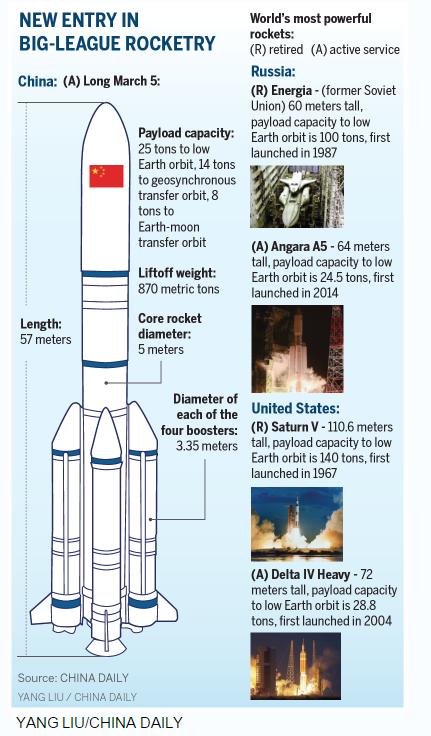Giant new rocket roars into space
The first Long March 5, a titanic heavy-lift carrier, pierced the heavens Thursday night
China launched its first heavy-lift Long March 5 carrier rocket late Thursday, marking a new milestone in the country's space industry.
As China's first-generation heavy-lift rocket, the Long March 5 has a liftoff weight of 870 metric tons, and a maximum payload capacity of 25 tons to low Earth orbit and 14 tons to geosynchronous transfer orbit.
The 57-meter-tall rocket, the tallest in China's carrier rocket family, thundered away with a blinding white flash from the Wenchang Space Launch Center in the island province of Hainan at 8:43 pm. It ferried the Shijian 17 scientific experiment satellite and a Yuanzheng 2 upper stage, which is capable of putting multiple payloads into different orbits during a single mission.
As the nation's strongest and most technologically advanced launch vehicle, Long March 5 will enable China to put its future manned station into space and send unmanned probes to Mars, according to the State Administration of Science, Technology and Industry for National Defense, which oversees the rocket's development.
China will start launching parts of its permanent manned space station starting in 2018 and put the station into service around 2022. The nation also will send an unmanned probe to Mars to orbit and land around 2020, said space officials.
The Long March 5 rocket has two core stages and four boosters. It uses liquid oxygen/kerosene and liquid oxygen/liquid hydrogen as propellants, making the rocket friendlier to the environment than previous Long March types, according to the China Academy of Launch Vehicle Technology in Beijing.
It has taken researchers 10 years to develop the Long March 5 after nearly 7,000 tests, the academy said.
"The Long March 5's payload capacity is about 2.5 times bigger than other major Chinese rockets. ... The bigger size is not just a simple enlargement, actually it represents tremendous breakthroughs in terms of design, testing and manufacturing capabilities," said Li Dong, chief designer of Long March 5 at the academy.
Li Bin, vice-president of the Academy of Aerospace Propulsion Technology in Xi'an, Shaanxi province, said researchers at his academy overcame numerous difficulties before working out the 120-ton-thrust liquid oxygen/kerosene engine, the main propulsion of Long March 5.
Long March 5 is the fourth new carrier rocket that China has launched over the past year. Long March 6 and 11 performed their maiden flights in September 2015 while Long March 7 carried out its first launch in June.
No other country has put so many new rockets into service in one year, experts said.
Fu Zhiheng, vice-president of China Great Wall Industry Corp, the nation's only authorized firm for international space collaboration, expects that Long March 5 will provide many opportunities in the commercial launch market because there are a great number of commercial satellites in the market that need powerful rockets to lift them.
Beyond Long March 5, the China Academy of Launch Vehicle Technology has begun to develop a super-heavy rocket that will have a takeoff weight of 3,000 tons and can lift a 100-ton payload into low Earth orbit.
If the research and development proceed well, the super-heavy rocket will carry out its first flight around 2030, and then it will enable China to land astronauts on the moon and to send and retrieve Mars probes, researchers at the academy said.
- Is it a thing? 10 odd jobs where you can make good money
- Message on a bottle: Mineral water company launches drive to find missing children
- Sun Yat-sen champion of national integrity, unity: Xi
- Four killed, two injured after house collapses in C China
- Cross-Straits forum held to commemorate Sun Yat-sen
















